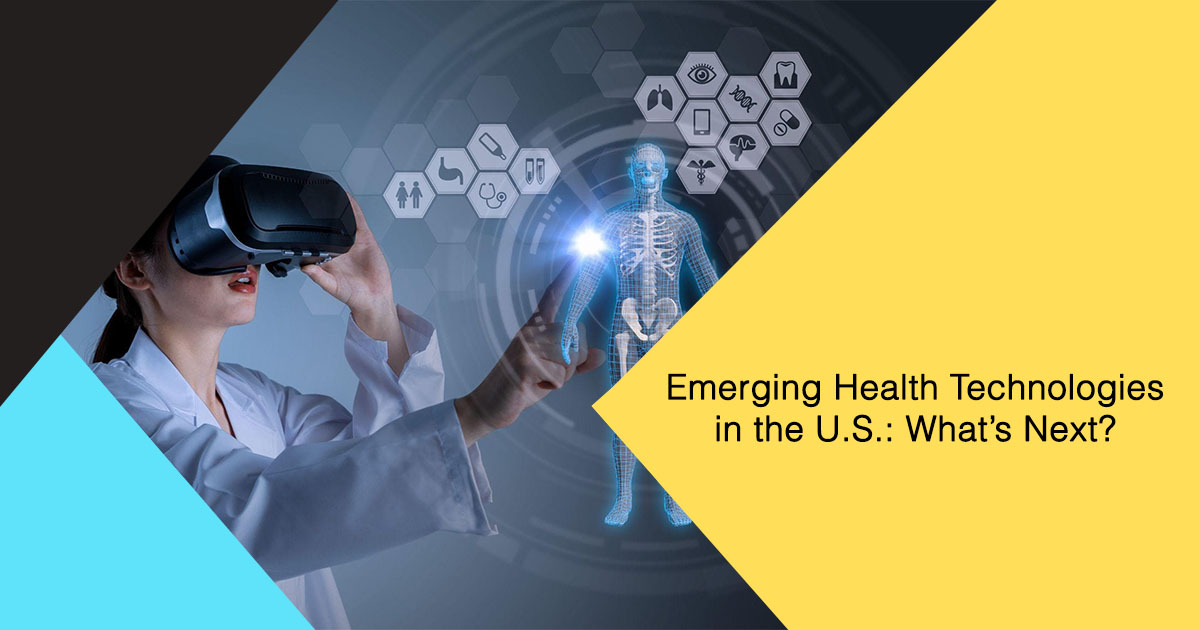Emerging Health Technologies in the U.S.: What’s Next?

Emerging health technologies in the U.S. are transforming how healthcare is delivered, managed, and experienced, with new innovations focused on personalized care, preventive medicine, and data-driven decision-making. Here are some of the most promising health technologies poised to shape the future:
1. Artificial Intelligence (AI) and Machine Learning in Diagnosis and Treatment
- AI is being used to analyze medical images, predict disease progression, and support clinical decision-making. Machine learning algorithms can detect patterns in complex datasets, helping physicians make faster and more accurate diagnoses.
- Examples include AI for analyzing radiology images, detecting early signs of conditions like cancer and heart disease, and even predicting patient outcomes based on electronic health records.
2. Telemedicine and Virtual Care Platforms
- Telemedicine has surged in popularity, offering remote consultations, follow-ups, and mental health services via video or messaging. Virtual care improves access to healthcare, especially for those in rural or underserved areas.
- The next wave includes virtual reality (VR) therapy for mental health, remote physical therapy guided by wearables, and telehealth platforms integrating diagnostic tools for real-time assessments.
3. Wearable Health Monitoring Devices
- Wearable devices, such as smartwatches and biosensors, can monitor heart rate, blood pressure, oxygen levels, and even blood glucose in real time. These devices provide continuous monitoring, which is invaluable for managing chronic conditions and personal wellness.
- The future of wearables includes non-invasive glucose monitors for diabetics, skin patches that analyze sweat, and smart clothing that tracks vital signs, all aimed at more personalized and proactive health management.
4. Genomic Medicine and Precision Health
- Advances in genomics allow for personalized treatment plans based on an individual’s genetic makeup. Genomic sequencing can reveal predispositions to diseases, helping in preventative care and early intervention.
- Precision health combines genomics with data from wearables, EHRs, and lifestyle factors to offer custom-tailored therapies, particularly for cancer, cardiovascular diseases, and rare genetic disorders.
5. Robotic Surgery and Automation in Operating Rooms
- Robotic-assisted surgeries enable greater precision, flexibility, and control during procedures. Surgeons can use robotic systems for minimally invasive surgeries, leading to shorter recovery times and fewer complications.
- The future includes AI-assisted robotic systems that can provide real-time feedback during surgeries and automated operating rooms where multiple robotic tools work together, reducing human error and enhancing patient outcomes.
6. 3D Printing of Medical Devices and Tissues
- 3D printing technology is increasingly used to produce customized medical devices, such as implants, prosthetics, and even surgical tools, tailored to individual patient needs.
- Researchers are exploring 3D bioprinting of tissues, which could one day enable the creation of human organs, offering a potential solution for organ transplant shortages. The ability to print patient-specific devices and tissues could revolutionize personalized medicine.
7. Digital Therapeutics and Mental Health Apps
- Digital therapeutics are software-based treatments that provide evidence-based interventions to prevent, manage, or treat diseases. These include apps for mental health, substance use disorders, diabetes, and more.
- The next phase will see FDA-approved digital therapeutics for a broader range of conditions, including chronic pain and neurological disorders, integrating with wearables and telemedicine for continuous support and real-time feedback.
8. Blockchain for Secure and Transparent Health Data Management
- Blockchain offers a decentralized, secure way to store and share medical records. It allows patients to control access to their health data and ensures that records are accurate and tamper-proof.
- Blockchain can enable seamless data sharing between providers, insurers, and patients, reducing administrative costs, preventing fraud, and improving continuity of care, especially in managing complex or chronic conditions.
9. Augmented Reality (AR) for Training and Patient Education
- AR is being used for medical training, allowing students and professionals to visualize complex anatomy and simulate surgeries in a virtual environment. It also helps patients understand their conditions and treatments better.
- Future applications of AR in healthcare may include "smart glasses" for surgeons to overlay critical information during operations and AR apps that educate patients about postoperative care.
10. CRISPR and Gene Editing Technologies
- CRISPR technology enables precise editing of genes and holds promise for curing genetic diseases. Clinical trials are exploring CRISPR’s use in treating conditions like sickle cell anemia, muscular dystrophy, and certain cancers.
- In the coming years, CRISPR could be used for treating a broader range of diseases, developing genetic-based vaccines, and even creating preventive therapies to address inherited conditions before symptoms appear.
11. Voice Technology and Natural Language Processing (NLP)
- Voice recognition and NLP are being used to improve clinical documentation, enabling doctors to input notes verbally. These technologies also support AI-powered chatbots that assist patients with medical queries.
- Future NLP applications may include virtual health assistants that help patients manage chronic conditions and improve treatment adherence, as well as smart home integration for elderly or disabled individuals who need hands-free control over health devices.
12. Regenerative Medicine and Stem Cell Therapy
- Regenerative medicine focuses on repairing or replacing damaged cells, tissues, and organs, often through stem cell therapy. Advances in this area could offer new treatments for conditions that currently have limited therapeutic options.
- Future applications include lab-grown tissues for transplants, stem-cell-based treatments for degenerative diseases, and personalized cell therapies that utilize a patient’s own cells to promote healing and regeneration.
13. Cybersecurity Solutions for Healthcare Data Protection
- As healthcare becomes increasingly digital, protecting sensitive health data has become critical. New cybersecurity solutions leverage AI to detect unusual patterns, prevent breaches, and protect patient data.
- Future innovations may include blockchain-based patient identification, biometric authentication, and AI systems that monitor network security continuously, helping prevent cyberattacks and data theft.
14. Nutrigenomics and Personalized Nutrition
- Nutrigenomics is the study of how genetics influence a person’s response to food, paving the way for personalized nutrition plans tailored to individual health needs, disease risks, and dietary preferences.
- Advances in this field could lead to tailored dietary supplements, custom meal plans that optimize health outcomes, and apps that analyze genetic data to provide personalized diet recommendations.
15. Wearable and Implantable Biosensors for Continuous Health Monitoring
- Biosensors, whether worn or implanted, allow continuous monitoring of biomarkers such as glucose, lactate, or blood oxygen, providing real-time data to patients and healthcare providers.
- Future applications include implantable sensors that detect infections, chronic disease markers, or even cancerous cells, as well as integration with AI to predict and prevent health issues based on continuous monitoring.
Challenges and Considerations
- Data Privacy and Security: With increased data collection, ensuring the privacy and security of patient information is paramount.
- Regulatory and Ethical Concerns: Technologies like AI, CRISPR, and digital therapeutics raise ethical and regulatory questions, such as data usage, genetic modification, and digital treatment approvals.
- Accessibility and Equity: Ensuring that emerging health technologies are accessible and affordable to all segments of the population will be essential in reducing health disparities.
Conclusion
Emerging health technologies in the U.S. are redefining healthcare with a focus on personalization, accessibility, and proactive care. From AI-driven diagnostics to wearable biosensors, these innovations promise to improve outcomes, enhance patient experiences, and support preventive medicine. As these technologies evolve, addressing privacy, regulatory, and accessibility challenges will be crucial for maximizing their impact on public health and wellness.










